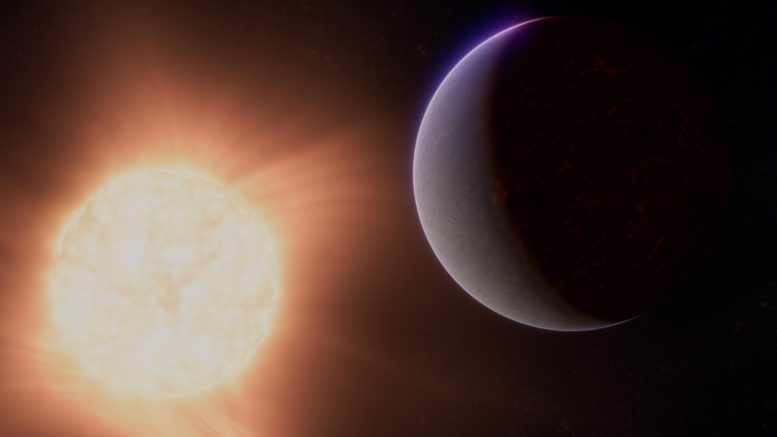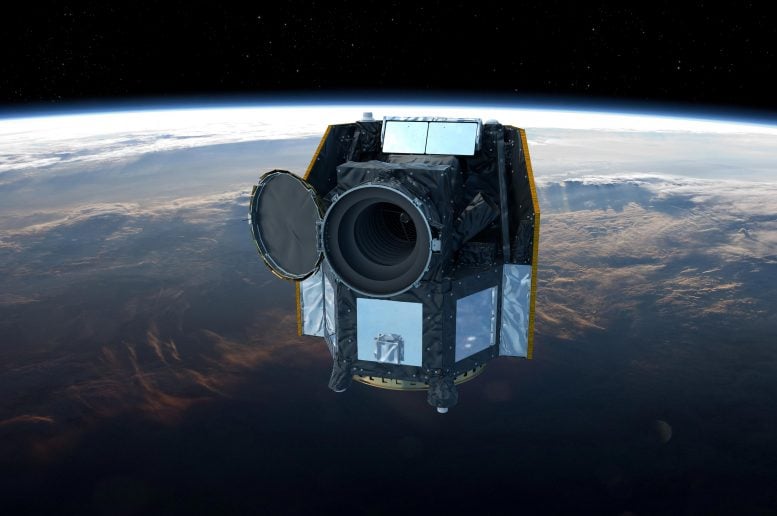
Recent observations by the James Webb Space Telescope have shed light on the enigmatic super-Earth 55 Cancri e, revealing its likely atmosphere composed of gases like carbon monoxide or dioxide. This discovery highlights the planet’s extreme conditions due to its proximity to its star, and its potential to offer insights into the early atmospheres of rocky planets.
55 Cancri e is one of five known planets orbiting a Sun-like star in the constellation Cancer. With a diameter nearly twice that of Earth and a density slightly greater, the planet is classified as a super-Earth: larger than Earth, smaller than Neptune, and similar in composition to the rocky planets in our solar system.
Brice-Olivier Demory from the Center for Space and Habitability CSH of the University of Bern and member of the NCCR PlanetS is co-author of the study that was just published in Nature.
He says: “55 Cancri e is one of the most enigmatic exoplanets. Despite enormous amounts of observing time obtained with a dozen of ground and space facilities in the past decade, its very nature has remained elusive, until today, when parts of the puzzle could finally be put together thanks to the James Webb Space Telescope (JWST).”
Unexpectedly, these observations show that it might be possible for a hot and highly irradiated rocky planet to sustain a gaseous atmosphere, and this bodes well for JWST’s ability to characterize cooler – potentially habitable – rocky planets orbiting Sun-like stars. Renyu Hu from NASA’s Jet Propulsion Laboratory (JPL) leads the team publishing their results in Nature. “JWST is really pushing the frontiers of exoplanet characterization to rocky exoplanets,” Hu said. “It is truly enabling a new type of science.”

CHEOPS Space Telescope Delivered Important Findings
Demory was invited to the research program by Hu who was one of his colleagues when he was at the Massachusetts Institute of Technology (MIT). Demory has been studying 55 Cancri e since the beginning of his career: “As a Postdoc at MIT I led the discovery of the first transit of 55 Cancri e, and in 2016 my team published the first map of a rocky exoplanet, which was 55 Cancri e.”
The 2016 result already hinted at the possible presence of an atmosphere around 55 Cancri e. For the current study, Demory conducted an independent analysis of the JWST dataset. He explains: “In the past two years, the space telescope CHEOPS which has been developed and built at the University of Bern, has been key in solving several questions that astrophysicists had about 55 Cancri e. JWST complemented this picture at infrared wavelengths in showing that the super-Earth 55 Cancri e might be surrounded by an atmosphere with a composition consistent with carbon monoxide or carbon dioxide.”
Super-Hot Super-Earth and Still Cooler Than Expected
Although 55 Cancri e is similar in composition to the rocky planets in our solar system, describing it as “rocky” could leave the wrong impression. The planet orbits so close to its star (a full orbit lasts 18 hours, compared to the 365 days of our Earth) that its surface must be molten – a deep, bubbling ocean of magma. With such a tight orbit, the planet is also likely to be tidally locked, with a dayside that faces the star at all times and a nightside in perpetual darkness. “The planet is so hot that some of the molten rock should evaporate,” explained Hu.
Although JWST cannot capture a direct image of 55 Cancri e, it can measure subtle changes in light from the system as the planet orbits the star. The team used JWST’s NIRCam (Near-Infrared Camera) and MIRI (Mid-Infrared Instrument) to measure infrared light originating from the planet. By subtracting the brightness during the secondary eclipse, when the planet is behind the star (starlight only), from the brightness when the planet is right beside the star (light from the star and planet combined), the team was able to calculate the amount of infrared light coming from the dayside of the planet at multiple wavelengths simultaneously.
The first indication that 55 Cancri could have a substantial atmosphere came from temperature measurements based on its thermal emission, or heat energy given off in the form of infrared light. If the planet is covered in dark molten rock with a thin veil of vaporized rock or no atmosphere at all, the dayside should be around 2200 degrees Celsius.
“Instead, the MIRI data showed a relatively low temperature of about 1500 degrees Celsius,” said Hu. “This is a very strong indication that energy is being distributed from the dayside to the nightside, most likely by a volatile-rich atmosphere.” While currents of lava can carry some heat around to the nightside, they cannot move it efficiently enough to explain the cooling effect. In fact, the dayside looks several hundred degrees cooler than it should, even if heat is spread evenly around the planet. This makes sense if some of the infrared light emitted by the surface is being absorbed by the atmosphere, and never reaches the telescope.
Bubbling Magma Ocean
The team thinks that the gases blanketing 55 Cancri e are bubbling out from the interior. The primary atmosphere would be long gone because of the high temperature and intense radiation from the star. This would be a secondary atmosphere that is continuously replenished by the magma ocean. Magma is not just crystals and liquid rock, there’s a lot of dissolved gas in it, too.
While 55 Cancri e is far too hot to be habitable, it could provide a unique window for studying interactions between atmospheres, surfaces, and interiors of rocky planets, and perhaps provide insights into the early Earth, Venus, and Mars, which are thought to have been covered in magma oceans far in the past. “Ultimately, we want to understand what conditions make it possible for a rocky planet to sustain a gas-rich atmosphere: the key ingredient for a habitable planet,” said Hu.
More on this research:
- Webb Finds Atmosphere on Rocky Exoplanet For the First Time
- First Atmospheric Discovery on a Rocky Super-Earth
Reference: “A secondary atmosphere on the rocky Exoplanet 55 Cancri e” by Renyu Hu, Aaron Bello-Arufe, Michael Zhang, Kimberly Paragas, Mantas Zilinskas, Christiaan van Buchem, Michael Bess, Jayshil Patel, Yuichi Ito, Mario Damiano, Markus Scheucher, Apurva V. Oza, Heather A. Knutson, Yamila Miguel, Diana Dragomir, Alexis Brandeker and Brice-Olivier Demory, 8 May 2024, Nature.
DOI: 10.1038/s41586-024-07432-x
Never miss a breakthrough: Join the SciTechDaily newsletter.